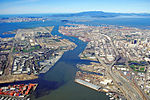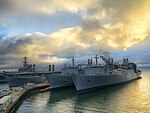St. George Spirits
1982 establishments in CaliforniaAbsintheAmerican rumsAmerican vodkasCompanies based in Alameda, California ... and 8 more
Distilleries in CaliforniaDrink company stubsFood and drink companies established in 1982Food and drink in the San Francisco Bay AreaRumsRums of the Pacific RimUse mdy dates from March 2022Whiskies of the United States
St. George Spirits is an artisanal distillery located in Alameda, California that produces a range of alcoholic beverages under the direction of Master Distiller Lance Winters. They are known for producing vodka, absinthe, whiskey, gin, brandy, liqueurs, and a range of exotic spirits.
Excerpt from the Wikipedia article St. George Spirits (License: CC BY-SA 3.0, Authors).St. George Spirits
Monarch Street,
Geographical coordinates (GPS) Address Phone number Website External links Nearby Places Show on map
Geographical coordinates (GPS)
| Latitude | Longitude |
|---|---|
| N 37.7876 ° | E -122.3093 ° |
Address
St. George Spirits
Monarch Street 2601
94501
California, United States
Open on Google Maps









